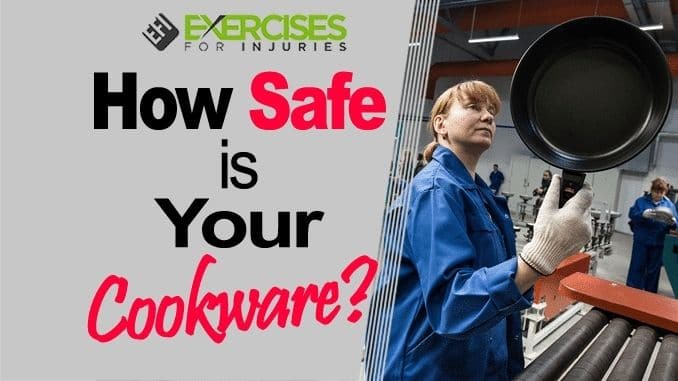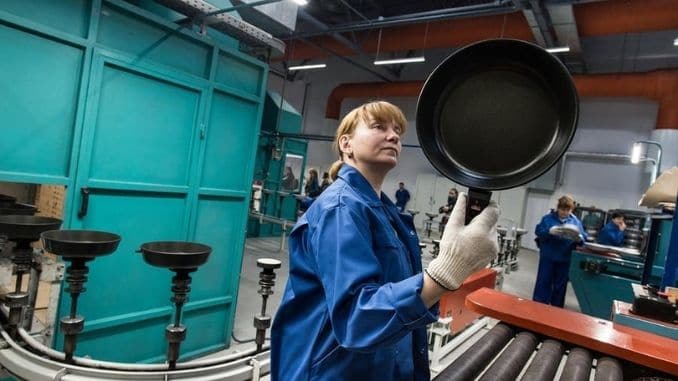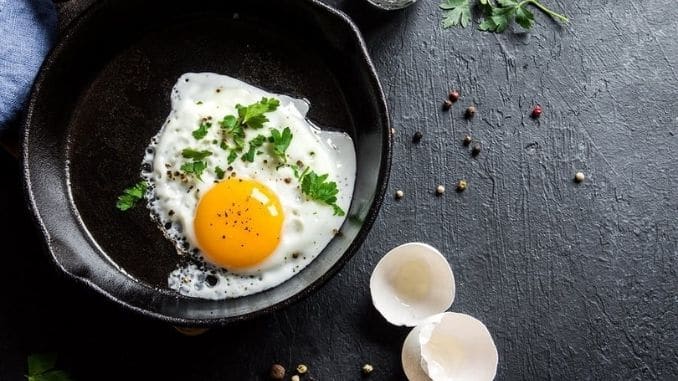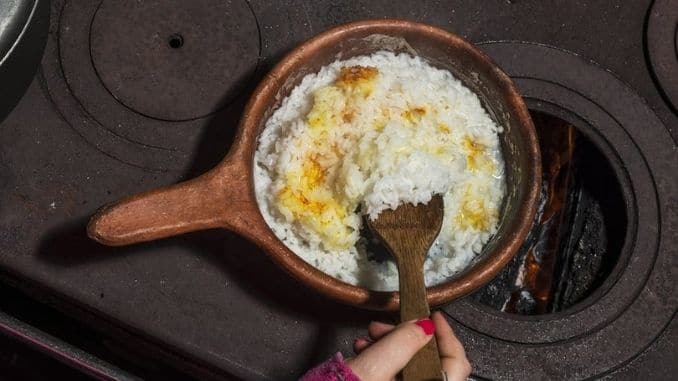
How Safe Is Your Cookware? Is some cookware safer than others in terms of toxic fumes, chemical reactivity or actual raw materials? How safe is that nonstick coating on your waffle iron? What about the silicone muffin pan or the cast-iron skillet that Grandma passed down? Is it true that pet birds have literally been killed by fumes emitted from certain nonstick cookware? How safe is your cookware?
Here’s an alphabetical list of cookware that’s available these days — and a breakdown of the safety considerations for each type.
Aluminum
Synopsis: Aluminum baking sheets are commonly used in restaurants and bakeries because of their durability, superior heat conductivity and relatively low cost.
Safety considerations for aluminum cookware: Aluminum is considered a neurotoxin by the United States Food and Drug Administration (FDA) and every other reputable think-tank worldwide. A neurotoxin is defined medically as a poisonous substance that acts on the nervous system and disrupts the normal function of nerve cells.
So, why put food on it or in it and heat it to high temperatures? It is true that aluminum is an extremely common element, present in many foods and water sources. But, common or not, it’s still a neurotoxin! Higher levels of aluminum in the blood have been linked to Alzheimer’s disease, certain cancers and weakening of the bones. The less aluminum we take in through our diets, the better. The acidity of certain foods, cooked on aluminum (or in aluminum foil) causes a reaction that allows small amounts of aluminum to be absorbed into the food. More aluminum is absorbed into foods if the pan is old or if ingredients have been stored in aluminum for a long period of time.
Anodized Aluminum Nonstick
Synopsis:
Anodized aluminum cookware has gained in popularity during the past couple of decades as consumers became wise to the risks of cooking on pure aluminum. Several cookware companies have begun anodizing the metal. The base of these pans is aluminum, which makes them excellent for even cooking and heat retention. According to the Aluminum Anodizers Council, anodizing is an electrochemical process that converts the metal surface into a decorative, durable, corrosion-resistant, anodic oxide finish. The claim is that the anodization “locks-in” the aluminum, making it a safe material on which to cook even the most acidic foods without aluminum leaching into our meals. For the most part, that’s true (trace amounts of aluminum are still present in foods cooked on anodized aluminum, but not much). Then, the anodized aluminum pans are coated with a nonstick surface.
Safety considerations for anodized aluminum nonstick cookware:
The more disturbing truth about anodized aluminum pans is that the nonstick coating of the most popular brands of anodized aluminum cookware contains a chemical called polytetrafluoroethylene (PTFE). PTFE releases gases at high temperatures that are toxic to pet birds and can cause a condition called polymer flu fever (among other ailments) in humans.
While researching nonstick cookware, I read several accounts of families losing beloved pet birds after using cookware containing PTFE near the bird cages. One family had an aviary of exotic birds — large birds like macaws and sun conures as well as some smaller breeds. The family bought a nonstick-coated pan. One day, they had placed their nonstick pan full of water on the stove to boil and forgot about it. When the water boiled dry, the hot pan sat in the kitchen, on the heat, emitting toxic fumes (fumes that are generally unnoticed by humans). As they realized that they had forgotten the pan, one of their rescued blue and gold macaws had fallen dead. One by one, they watched more of their exotic birds die that evening — 55 in total, from nothing more than a very hot nonstick pan and its toxic fumes.
We recommend discarding any nonstick cookware in your home that contains PTFE or perfluoroalkyl vinyl ether (PFA), which is equally as toxic and found in older nonstick cookware.
Cast Iron
Synopsis: Cast-iron cookware has literally been utilized for centuries. Samantha Johnson, author of The Beginner’s Guide to Vegetable Gardening, says there’s evidence that the Chinese were using cast iron more than 2,000 years ago. You can cook with it over an open fire, on top of a modern stove or in the oven. Cast-iron cookware is valued among professional chefs and foodies for its durability, heat retention and versatility. While cast iron doesn’t have a nonstick coating, once a well-seasoned cast-iron pan is preheated, most foods will not stick to it. Some people call cast iron “the original nonstick cookware.”
Safety considerations for cast-iron cookware: Because cast iron is made of iron, trace amounts of the mineral will leach into your food if you cook with cast-iron pans. This small amount of iron is not a safety concern for most people. However, if you have a rare genetic disorder called hemochromatosis (iron overload), you shouldn’t cook with or eat food made with cast-iron cookware. Other than that, we couldn’t find anything unsafe about cast iron.
100 Percent Ceramic
Synopsis: Made entirely from natural earthen ceramic clay, then fired and glazed, 100 percent ceramic cookware is the choice of many natural chefs for its green appeal. Ceramic cookware isn’t nonstick.
Safety considerations for 100 percent ceramic cookware: We couldn’t find any.
Ceramic-coated Nonstick
Synopsis: Made popular by people who like nonstick cookware but don’t like the fumes from the nonstick coating. Moreover, ceramic-coated nonstick cookware is aluminum pans with a proprietary coating of ceramic sprayed over the top to create a slick, nonstick coating. The leading brand of ceramic-coated cookware does not use PTFE or any other known toxins in its ceramic nonstick coating.
Safety considerations for ceramic-coated nonstick cookware: The main issue many face with ceramic-coated cookware is the short lifespan of the nonstick coating. Consumers largely report that some brands of ceramic-coated cookware only last a few months before the coating begins breaking down. If you must have coated, nonstick cookware, ceramic is likely the least toxic option on the market today. However, if the coating wears off, there is a risk of that proprietary ceramic coating blistering off into the food being cooked in the pan. Moreover, if you have these pans or plan to buy them, cleaning them very well after each use and never using cooking sprays will prolong the life of the nonstick coating.
Clay
Synopsis: One of the least common yet oldest forms of cookware is made from clay — right from the crust of our glorious Earth. Chefs who cook exclusively with clay cookware enjoy the way the cookware holds in heat and moisture.
Safety considerations for clay cookware: We couldn’t find any.
Copper
Synopsis: Copper is an excellent metal for heat conductivity and is often preferred for cooking. It is normally lined with another metal or substance for cooking.
Safety considerations for copper cookware: Much like other metal cookware, copper can leach into your foods during cooking, particularly when cooking acidic foods. The body needs copper in small amounts only. If you cook on copper every day, for every meal, you might conceivably end up with toxic levels of copper in your blood. If you plan to cook food regularly on copper cookware. It’s best to use a copper pan that is lined with another durable metal like stainless steel.
Enameled Cast Iron
Synopsis: These are cast-iron pieces glazed with a ceramic coating. They are excellent for people who cannot have added iron in their diets from raw cast-iron pans. They also hold heat well and can be coated in many lovely colors to match the kitchen.
Safety considerations for enameled cast iron cookware: Back in the 1970s (and prior), the enameled coating on cast-iron pans sometimes contained cadmium and lead. Both of those ingredients are toxic and should never be used in cookware. While Aunt Linda may want to keep Grandma’s bold orange cast-iron crock in the family, it’s best not to cook anything in it — just to be on the safe side.
We couldn’t find any safety considerations for enameled cast-iron pans made in the current century.
Glass
Synopsis: Glass cookware is durable and has been around for ages. There are various brands on the market today. It is extremely affordable.
Safety considerations for glass cookware: Aside from a few isolated cases of certain glassware bursting during use, we couldn’t find any negative health issues associated with cooking on or in glass cookware.
Stainless Steel
Synopsis: Home cooks and professional chefs alike use stainless-steel cookware in their kitchens for its durability and relative affordability.
Safety considerations for stainless steel: Moreover, most high-quality stainless-steel pans have a base of aluminum, copper and/or nickel to reinforce the pan and improve heat conductivity. These other metals are sandwiched between layers of stainless steel to prevent them from leaching into the food being cooked. If a stainless-steel pan is pitted or dented, there’s a chance you could be letting other, more harmful metals, get into your food while it’s cooking. Don’t use any stainless-steel cookware that is chipped or otherwise worn out. Otherwise, stainless steel is a safe choice in cookware.
Silicone
Synopsis: Silicone cookware is a synthetic rubber-type cookware made from bonded silicon. Silicon is a natural element found in rocks and sand. Many bakers prefer silicone baking pans because they offer a fairly nonstick and flexible surface, making it easy to remove cooked items.
Safety considerations for silicone cookware: While silicone cookware hasn’t been shown to leach into foods or emit dangerous gases, it hasn’t been studied much. The FDA has deemed it safe. However, the FDA deems lots of things as safe — and later we find out they’re not. Moreover, we regard silicone cookware with caution. Not much research has been conducted on the cookware in terms of safety when cooking with high heat.
Stone Cookware
Synopsis: Stoneware is normally made of heavy-duty ceramic or some other earthen material. It’s excellent for use in baking and, after repeated use. It becomes somewhat nonstick due to oil absorption.
Safety considerations for stone cookware: Moreover, similar to 100 percent ceramic cookware and clay cookware, we couldn’t find any safety issues for stoneware. However, know your brand and do your homework. Avoid any stoneware that is glazed, unless you’re sure the glaze is safe for high-heat cooking.
Chemical Reactivity and Our Food
Recently, a 9-year-old told me how she didn’t like the bottled water she was drinking because of the “plasticky” taste. Canned vegetables have an entirely different flavor than fresh or frozen ones. Moreover, hot coffee from a foam cup tastes like — well, hot coffee from a foam cup. Reactive vessels in which we store and cook our foods will not only change the taste but often the toxicity of the foods we eat. The ions in our food will react to the ions in synthetic or metal cookware.
Low-risk or Nonreactive Cookware
In our research, we found that unglazed clay, 100 percent ceramic cookware and stone cookware are nonreactive and safe options. Other relatively safe cookware includes cast-iron and stainless-steel products.
If you have nothing but older, peeling, nonstick pans in your cupboards, it’s time to make a change. We recommend buying one pan from the low-risk category and using it primarily as you budget for an entire set of safer cookware.
Cookware companies seem to pop up daily with new claims about the safety of their nonstick or higher quality cookware. Use our research to help you choose safe cookware will work best in your home.
For your guide to the best foods to heal your body, check out The Best Foods that Rapidly Slim & Heal in 7 Days, here!






